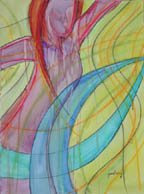The Hemorrhaging Woman
By Debra Dean Murphy
June 24, 2009

Mark 5:21-43 (Fourth Sunday After Pentecost)
(Image: Holy Spirit Dance, Gwen Meharg, watercolor.)
When we read the story of Jesus healing the hemorrhaging woman (or a leper or a paralytic or the demon-possessed), it’s tempting to see only the private moment—a two-person encounter isolated from the larger social order.
But these meetings—while they are personal and often quite intimate—are also confrontations: they are conflicts between an old order and a new one; between a religious system rooted in purity codes and the fear of bodies (women’s especially) and an alternative social practice meant to signal God’s coming reign of wholeness and well-being.
The encounter between Jesus and the hemorrhaging woman is this kind of confrontation, this kind of conflict. First, the woman approaches Jesus—a social and religious taboo of the highest order. Not only will she render Jesus unclean by coming into contact with him, she will compromise the purity of the whole group.
We are conditioned in our culture to think of healing as first of all a highly individualized, exclusively physiological event. But Scripture is quite clear that healing has to do with the mending of all creation, and that curing the sick has to do primarily with restoring a person to his or her community. At its most basic level, health involves, as EP endorser Joel Shuman has written, “a set of assumptions about the relationship of a person to his or community and its place on earth.”
So well-being is not just about a clean bill of health for me from my doctor, but also must be about the well-being of the place I live, the people (and plants and animals) I interact with, the entire community of which I’m a part. As Wendell Berry puts it: “the community—in the fullest sense: a place and all its creatures—is the smallest unit of health and... to speak of the health of an isolated individual is a contradiction in terms.”
When we pray for someone to get well—to be healed of an illness or infirmity—our prayer also ought to be for the well-being of the place, the people, the neighborhood, the land: the whole “kin-dom” to which that person is connected, “kin to,” as we say in the South—to which he or she is bound in relationships of mutual responsibility and care.
When Jesus says to the woman, “Daughter, your faith has made you well; go in peace, and be healed of your disease,” it is an invitation to full restoration. He is inviting her (and us) into the Kin-dom/Kingdom of God where the last shall be first; where the hungry are filled with good things; where enemies become friends; and where diseased, broken bodies become part of the One Body—taken, blessed, broken, and shared with a suffering, waiting world.